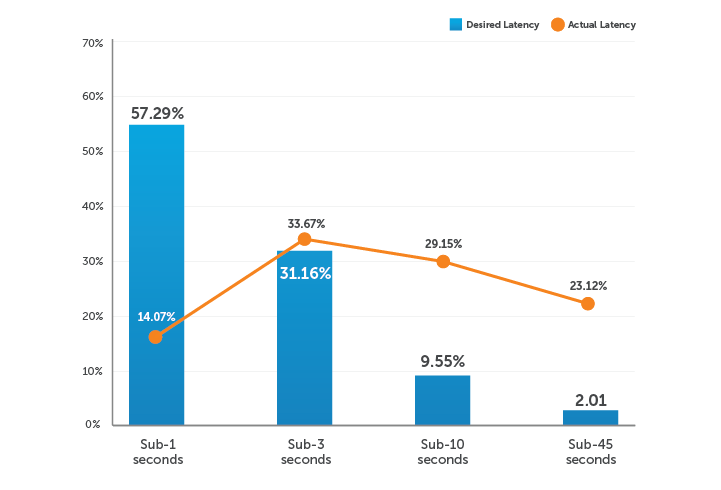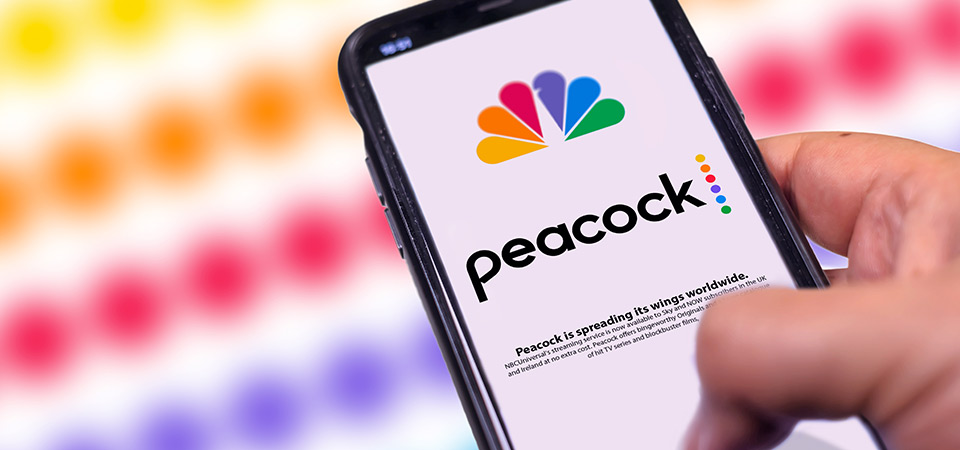10 Streaming Trends for 2022

We’ve said it before, and we’ll say it again: video is revolutionizing business.
The healthcare sector now relies on video-connected wellness devices, remote surgical capabilities, and smart hospitals equipped with AI-based surveillance. Both at home and in the clinic, streaming technology has become essential to delivering care.
In the consumer world, digital shopping platforms are thriving as physical stores shutter their doors. Those brick-and-mortar environments that continue to lure in customers do so using in-store shoppertainment technology like virtual fitting rooms.
Then there are the tech giants like Google, who’ve built video into every aspect of their strategy — from their services (YouTube and Google Meet) to their streaming-enabled products (Chromebook, Pixel, and Nest, to name a few). Even Facebook *ahem* Meta has pivoted its entire strategy to focus on video technologies like augmented and virtual reality (AR/VR).
Meanwhile, the widespread accessibility that streaming technology affords users is placing more power into creators’ hands. All things blockchain, crypto, Web3, and more are driving decentralization. In turn, new monetization models that sidestep big companies will thrive.
For many of the trends highlighted below — AR/VR, shoppable video, betting — low latency remains a critical capability. Data analytics and cross-vendor interoperability are also major themes that we’ll cover throughout.
So, buckle up. Here’s our list of the top ten streaming trends for 2022.
Top 10 Streaming Trends for 2022
- Hybrid Everything
- AR, VR, and the Metaverse
- Big Tech Teams Up With Big Sports
- Low Latency Remains Critical
- Actionable Data and Analytics
- OTT and the Rise of Free, Ad-Supported TV (FAST)
- Short-Form Video Growth and User-Generated Content
- Blockchain and Non-Fungible Tokens (NFTs)
- Web3 and the Decentralized Internet
- Interoperability Across Streaming Workflows
1. Hybrid Everything

In 2022 (or is it 2020, too?), businesses are shifting from ‘remote by necessity’ to ‘hybrid by design.’
Forget about the workplace. Connected retail, digital fitness, virtual education, and every other segment imaginable will embrace hybridization, blurring the dichotomy between on-site and remote. Video will continue to play a critical role in these hybrid settings — whether it’s the VR fitness booth offered at your gym or the next-generation treadmill taking up space in your home office. In fact, Gartner lists video as the number one enabling technology towards this hybrid future.
In traditional media and entertainment, watch party features that combine real-time interactivity with one-way broadcasting have already gained traction. Instead of having to share the couch with friends for each Boba Fett release, Disney+ subscribers need only share their screen using GroupWatch.
Then there’s Fan Controlled Football (FCF). Using Twitch or the FCF app, viewers are able to call plays in real time. Drones, helmet cameras, and VR are employed on the field to deliver a “Madden view” of the games.
Expect these types of interactive experiences to take hold across the board as the hybrid model becomes standard.

2. AR, VR, and the Metaverse
If you find the concept of a metaverse vague, you’re not alone. Conceiving of it is akin to imagining the internet without ever using a computer. After all, most of us have yet to experiment with sophisticated AR and VR technology.
Several factors have contributed to this, including the low quality and processing power of early VR headsets, the overall costliness for consumers and content distributors, and bandwidth limitations. Luckily, these obstacles are disappearing. We should see an uptick in adoption with newer hardware and 5G connectivity.
But what about the metaverse? What does that really entail?
According to Mark Zuckerberg, it’s all about making the internet more natural, vivid, social, and immersive.
In one sense, the metaverse is ‘hybrid everything’ at its finest — a world unto itself that merges physical and digital using extended reality (XR) technologies like AR, VR, and, of course, video galore. But early examples of the metaverse are already out there. Namely, in gaming.
Roblox and Fortnite both offer user-created immersive worlds, albeit currently experienced on a flatscreen. Virtual communities socialize, exchange digital assets, and ultimately build their own reality within these mini-metaverses. In Zuckerberg’s future, users would be able to travel from one of these platforms to another — thus enabling a singular metaverse. As such, a lot of its promise hinges on interoperability between metaverses (openness) and safety within them (security) — both of which we’ll dig into below.
Netflix already shared that in vying for viewers, they “compete with (and lose to) Fortnite more than HBO.” For this reason, the budding metaverse will result in gamification of all media platforms, which segues nicely to our third trend.
3. Big Tech Teams Up With Big Sports

Analysts have long held sports broadcasts as the saving grace for traditional television, with NFL games making up seven of the top ten televised events in 2020.
Nevertheless, networks like Disney and NBC have expanded their deals with the NFL to stream the games on their own OTT platforms (Disney+ and Peacock). And when it comes to Thursday Night Football, today’s viewers now need an Amazon Prime subscription to tune it at all.
Sports betting apps like FanDuel and BetMGM have also seen extraordinary growth in the U.S. due to recent legislation. Likewise, Europe’s online sports betting market has flourished with the COVID-19 pandemic.
It’s difficult to catch an NFL game today without being bombarded by commercials for these sportsbooks. Arenas and stadiums are bedecked with signage promoting them. As if that weren’t enough evidence that major sports leagues are cozying up with sports betting, these relationships are now informing decisions about everything from adding new teams to the number of games in the regular season.
NBC Sports Mike Florio writes:
“As legal sports wagering spreads, the cash spent by the in-stadium crowd matters less than the revenue from, for example, live in-game wagering via real-time broadcasting of the games with no latency. (It’s coming.) At that point, what matters is how the game is televised, not where the game is played.”
So what gives? All signs point to the combination of video streaming and betting as a significant source of future sports revenue. Betting overlays would be the logical next step, and with Amazon now controlling exclusive rights to Thursday Night Football, the industry’s move toward interactive streaming-based video distribution has already begun. We’d wager on Amazon leveraging the technology built into their gaming platform, Twitch, to support commenting, replays, access to stats, and in-game betting within the primary broadcast.
Likewise, sportsbooks will transform into media outlets in their own right — complete with top-notch journalism, pre-game analysis, and behind-the-scenes content. Table tennis, golf, and horse racing have all gained viewership from this trend, and made-for-betting events like celebrity boxing matches are starting to pop up.
4. Low Latency Remains Critical

One technology underpins all three of the trends detailed above: low latency.
For hybrid everything, speedy video delivery will seamlessly blend the digital and physical, thus enabling doctors to operate remotely and musicians to collaborate live from every corner of the world. Creating a truly immersive metaverse (or even an appealing live VR streaming experience) also starts with reducing lag. And when it comes to legal online wagering, low latency is table stakes.
Business continuity, public safety, and day-to-day activities all now depend on real-time video thanks to the pandemic. As a result, low-latency streaming has transformed from a nice-to-have to a key requirement.
More than 57% of content distributors surveyed in our 2021 Video Streaming Latency Report were hoping to achieve sub-second delivery in the future — citing interactivity and hybrid environments as their motive. Despite this, most were stuck in the 3-45 second range.
How much latency do you hope to achieve in your video workflow?

So, what all goes into making low-latency delivery a reality? Connectivity, for one thing. Content is only as fast as the network it traverses, which is why 5G has captured so much interest over the past few years.
The streaming protocol used to deliver a live stream also makes a huge difference. That’s where next-generation formats like WebRTC, SRT, and Low-Latency HLS come into play.
But even with advancements in connectivity and streaming technology, real-time streaming is difficult to pull off. Interactive environments are prone to buffering, jitter, and failure. The more people tuning in, the more error-prone these workflows can become. Achieving smooth, low-latency video delivery requires a substantial digital infrastructure, with a platform like Wowza at the crux of it all.
Get the low-latency streaming guide
Understand the critical capabilities required to provide interactive live streaming experiences.
Download Free5. Actionable Data and Analytics
We possess more data than ever before. However, this serves as little more than digital clutter without effectively analyzing and acting upon it. Data automation will separate industry leaders from the rest of the pack in the years to come and give rise to new capabilities altogether.
Need to gain real-time observability into stream performance? Data is the answer. Hoping to deliver more targeted ads based on viewer demographics? Try tapping into data.
The digital video supply chain is a goldmine of data — with the potential to improve quality of experience (QoE), content classification, ad targeting, and more. It starts with applying a proactive, analytical strategy to the digital information already floating around.

A prerequisite is interoperability across vendors. Most streaming ecosystems are made up of disparate systems and vendors, making it difficult to pinpoint the source of a streaming issue. End-to-end visibility requires integration between the encoder, content delivery network (CDN), and player. Likewise, dynamically serving up targeted ads requires streamlined communication throughout the workflow.
At Wowza, we continue to enhance monitoring and observability across our platform to support these capabilities. We’re excited to see how OTT giants like Amazon Live and social media platforms like TikTok also capitalize on data analytics — which brings me to our next two streaming trends.
6. OTT and the Rise of Free, Ad-Supported TV

At the dawn of over-the-top (OTT) media, paying for premium content made sense. But with the sheer volume of platforms, series, and even direct-to-VOD movie releases, our dollars are stretched thin. Consumers will continue to subscribe to a handful of platforms and shell out the big bucks for pay-per-view content throughout 2022. That said, free, ad-supported TV (FAST) services will also vie for viewers.
It used to be that watching ad-supported television meant suffering through countless commercials for irrelevant pharmaceuticals. With the ability to serve more personalized, engaging ads based on viewer data, this is no longer the case. Localization, viewer demographics, and two-way functionality all help toward this end.
Virtual linear (vLinear) ad-supported channels like Pluto TV, Peacock, and Roku are expected to double their viewership this year. According to the recent nScreenMedia report Getting FAST: The Explosive vLinear Market and Why Content Providers Need to Jump In, the FAST market in the U.S. will be worth $4B in 2023.
So, what can viewers expect from hyper-targeted FAST OTT? Imagine an infomercial about a weight loss supplement shortly after browsing for dieting products online, or an ad for anti-frizz shampoo when humidity is at its worst.
Interactivity will also take center stage. Expect innovative formats and gamification to increase engagement, giving viewers the option to pick their own adventure or toggle between product choices.
We’ve already grown accustomed to these very models on social media platforms — and the prevalence of advertising on Instagram et al. certainly hasn’t decreased usage. Likewise, the consumer perception of such personalized advertising has quickly moved from creepy to convenient.
7. Short-Form Video Growth and User-Generated Content (UGC)
On the one hand, we have highly produced media ranging from Squid Games to the Beijing 2022 Winter Olympics. On the other, we’ve got informal short-form content à la TikTok, Instagram Reels, and the like. Both forms are battling for eyeballs, and with only so much viewing time in a day, short-form content is eating into Netflix’s market share.
Today’s viewers like to devour their metaphoric content cake and snack on it, too — which is to say that snackable and binge-worthy videos compete directly. With user-generated content (UGC) now banking screen time traditionally dedicated to OTT platforms, new revenue streams are growing.
Shoppable video is among the most promising developments in this area, and a trend we’ve been tracking for several years. Retailers are relying on both live and short-form content to build out these virtual shopping environments, as well as technologies like extended reality (XR) and machine learning (ML).

Instagram and Facebook now offer Live Shopping, Google is experimenting with Shoploop, and Amazon delivers a multi-channel experience on Amazon Live. Walmart has even teamed up with TikTok to host live stream shopping events during the past two holiday seasons.
Most of these e-commerce platforms were built for UGC. As such, they’d do well to follow TikTok’s lead in prioritizing content personalization. The social media app attracts 1 billion active users each month, and its parent company, ByteDance, attributes this success to ML-powered content aggregation:
“We build intelligent machines that are capable of understanding and analyzing text, images, and videos using natural language processing and computer vision technology. This enables us to serve users with the content that they find most interesting, and empower creators to share moments that matter in everyday life to a global audience,” explains a ByteDance representative.
8. Blockchain and Non-Fungible Tokens (NFTs)
Whether you’re an influencer leveraging short-form video to grow your fanbase or a brand tapping into UGC to convert new leads, non-fungible tokens (NFTs) should prove a powerful tool.
NFTs are difficult for anyone to wrap their head around. But for the purposes of this article, this introductory video is a great place to start:
To reiterate, NFTs are unique blockchain-based certificates that store metadata about ownership, copyright, and authentication of a digital asset. Basically, they enable content creators to get paid directly without going through any third-party providers. The value of NFTs revolves around secure monetization, as well as the ease by which they can be exchanged.
Just as traditional wealth can be measured in terms of both cold hard cash and one-of-a-kind assets (think art and collectibles), digital wealth can be measured in terms of both cryptocurrency and NFTs. NFTs are not art in themselves, but the ownership and authentication of it. They can also act like tickets to experiences rather than being tied to objects. Thus, for creators selling digital videos, graphics, tweets, exclusive club memberships — you name it — NFTs put economic control back in their hands.
Advertising has been the primary means of converting content into cash since the dawn of the internet. But with NFTs, monetization can be achieved through a simple transaction rather than third-party intermediaries like YouTube. What’s more, an NFT can contain a smart contract that gives creators royalties on future sales or resales.
Coinmonks’ Doug Shapiro sees NFTs as providing value to both parties:
“Many discuss NFTs as a tool to empower the creator class, enabling them to break the yoke of the centralized platforms that extract high rents and mediate the relationship between creator and fan.
Nevertheless, I believe the next 100 million NFT users are more likely to be attracted by well-known film, TV, music, and sports stars and franchises than by punks, apes, or rocks. To capitalize, every media company should be mapping out an NFT strategy, right now. Part of the reason is just money.“
What does this mean for video streaming? Content protection, monetization, and distribution models will evolve as NFTs become more commonplace. NFTs promise to democratize how video content is exchanged and redefine the digital economy.
9. Web3 and the Decentralized Internet
All of this paves the way to a decentralized internet, termed Web3. Think of Web3 as the dot-com era’s woke grandchild. Web3 redistributes power from the overlords to the people, making the leap from a corporate internet oligarchy to a democracy of individual creators and owners. Geographic borders, organizational boundaries, and the digital walls separating proprietary apps and services will all falter in the face of Web3.
“[NFTs and other distributed ledger technologies (DLTs)] are helping businesses and organizations streamline business processes and operations and drive value through the creation of new digital business models. Their ability to build trust outside of organizational boundaries without the use of traditional intermediaries profoundly changes the way value can be created and delivered — and, like the internet, they’re transforming how business is conducted across industries and ecosystems.”
Blockchain technology and Web3 will be the building blocks of the user-created metaverse, streamlining interoperability across different platforms.
10. Interoperability Across the Streaming Workflow
We see this same momentum towards a more open, unencumbered internet happening in the streaming industry.
Flash Player has finally died, allowing vendor-agnostic protocols like Web Real-Time Communications (WebRTC) and Secure Reliable Transport (SRT), and CMAF for DASH to gain a foothold.
It bears noting that these open-source standards often outperform their proprietary alternatives — replacing legacy technologies with modern frameworks. Computerworld’s Shan Sinha explains,
“WebRTC benefits from having thousands of software developers working on it in concert, standardizing conferencing protocols and making interoperability less of a concern. Most companies can’t compete with thousands of independent developers contributing code to a platform — even organizations as large as Google and Apple pale in comparison to a web community-driven effort.”
Industry leaders are also partnering to improve interoperability by developing common formats. CMAF represents an attempt made by Apple and the Moving Pictures Expert Group to eliminate complexity, whereas the AV1 video codec came about via an alliance formed by Amazon, Netflix, Microsoft, Cisco, and Mozilla. Beyond protocols and codecs, efforts are being spearheaded by the Streaming Video Alliance Quality of Experience (QoE) Working Group and the Consumer Technology Association (CTA) to standardize data collection for monitoring and observability.
At Wowza, we developed our software and services to provide flexibility for countless formats, devices, and requirements. We’re also continuing to integrate additional technologies into our platform to eliminate complexity and are fully committed to supporting this trend.
Bring It On, 2022
The streaming industry remains as dynamic as ever, with a lot to be excited about in 2022.
For whatever you’re trying to build, Wowza delivers the technology and expertise required to shape the future of video. It’s simple: If you can dream it, Wowza can stream it.
Contact us today to learn more.




